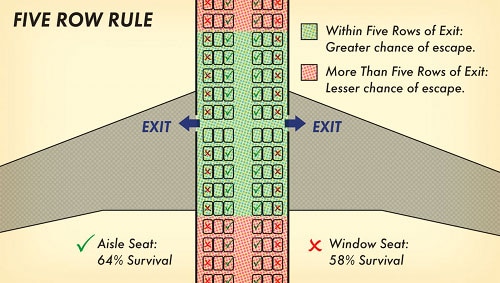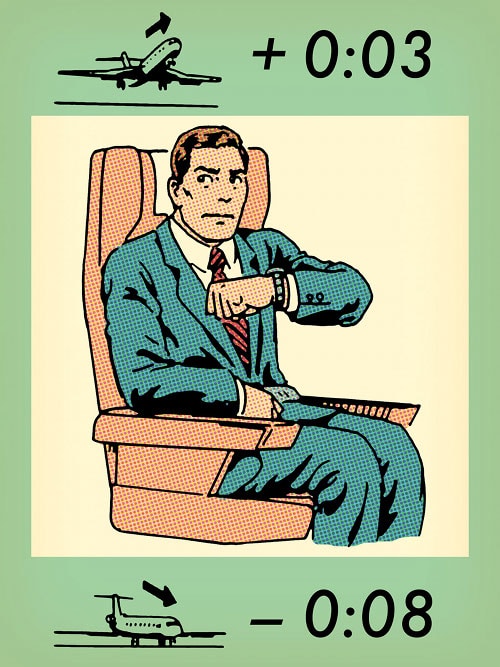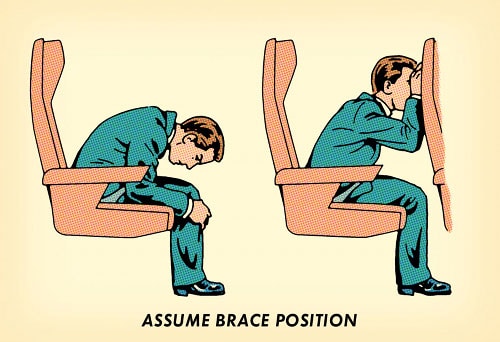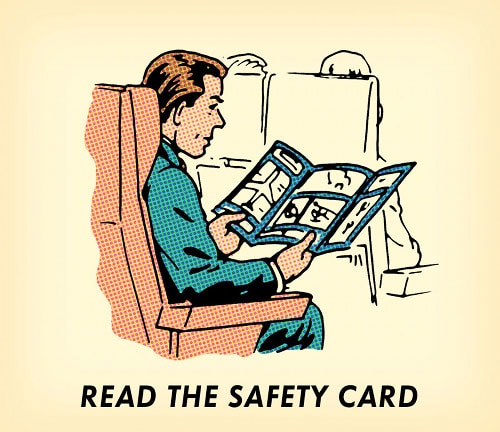
With our archives now 3,500+ articles deep, we’ve decided to republish a classic piece each Sunday to help our newer readers discover some of the best, evergreen gems from the past. This article was originally published in July 2013.
We often think that plane crashes are catastrophic and unsurvivable events. Thanks to movies and 24/7 news channels, the enduring image of a plane crash usually involves an aircraft plummeting to the ground from 30,000 feet and obliterating everyone on board in a terrifying fireball.
Thankfully, that isn’t the case. In a report analyzing airline accidents from 1983 to 2000, the National Transportation Safety Board found that the survival rate of crashes was 95.7%. Sure, there are some accidents where everyone, or nearly everyone, died, but those are much rarer than you’d guess based on what you see in the news. The NTSB found that even in serious accidents where fire and substantial damage occurred, 76.6% of passengers still survived.
Combine those stats with the relative rarity of airplane accidents even happening in the first place (the average American’s chances of being killed in an airplane crash are about 1 in 11 million), and you can see that flying is actually the safest form of transportation there is. Taking to the road on an average day is far more dangerous — it just doesn’t feel like it because you have four (or two) wheels on the ground and a sense of control.
But it’s important to take note of another interesting tidbit that the FAA and NTSB found in their research on plane crashes: 40% of fatalities that did occur happened in crashes that were survivable. Close to half of all airplane crash fatalities might have been prevented had passengers taken proper action.
While the odds of being involved in a plane crash may be slim, they’re not zero. If it happened to you, would you know what to do to increase your chances of walking away? In today’s article we’re going to offer research-backed advice from Ben Sherwood’s The Survivor’s Club on what you can do to make it out of a plane crash alive.
You’ve Only Got 90 Seconds to Get Out
Understanding this is the key ingredient to surviving, and will frame all the other tips in this article. If you’ve survived the crash landing, you have a pretty good chance of getting out of the airplane alive. But, you only have 90 seconds to do so.
You see, the thing that kills most passengers in a plane crash isn’t the actual impact, it’s the fire that typically engulfs the plane afterwards. Folks may be surprised they survived the impact, and become complacent about other dangers. People vastly underestimate how quickly a fire can spread and consume an airplane. Surveys show that most people think they actually have about 30 minutes to get out of a burning plane. The reality is that it takes, on average, just 90 seconds for a fire to burn through the plane’s aluminum fuselage and consume everything and everyone in it. If that sounds scary, it should; you need to be motivated to get your rear end out of the plane!
Be Fit
The FAA has rigorously studied and crunched the numbers on airplane crash survivors, as well as tested nearly 2,500 people in simulated evacuations to find out the type of person who typically survives. Their results?
Young, slender men have the best odds of surviving a plane crash. (Old, fat women have the worst odds — sorry Aunt Myrtle.)
The FAA has found that differences in age, gender, and girth account for 31% of the difference between people’s evacuation times. Escaping a plane crash requires you to maneuver quickly through narrow aisles with luggage and wreckage strewn about. You may even have to throw blockages out of your way. You then have to slip through an emergency exit that may only be twenty inches wide. Kind of hard to do if you’re fat and out of shape.
Not only can being out of shape reduce your chances of survival, it could also put other people’s lives at risk because they have to wait for you to exit safely. Hold-ups at the exit due to passengers having trouble deplaning has caused many unnecessary deaths. In a runway collision that occurred in 1991, investigators found the charred remains of 10 passengers lined up in the aisle waiting to leave the wing exit; folks who froze up and had trouble squeezing through the exit had created a fatal bottleneck.
If you’re on the rotund side, make it a goal to shed some of that table muscle so you’ll be fit enough to save your own life and perhaps the lives of others (and not just on a plane, either, but in all kinds of survival situations). We’ve got plenty of workouts on our site to choose from to get started.
Fly in Bigger Planes if Possible
If you have the choice between flying in a puddle jumper or a 737, choose the 737. According to FAA investigations, larger planes have more energy absorption in a crash which means you’re subjected to less deadly force, and that may equate to a better survival rate. Consider flying on Southwest — whose fleet consists solely of 737s — and avoid regional carriers when possible; not only are their planes smaller, they have an accidents and incidents rate double that of national carriers and their pilots are often less experienced and overworked. Note that national airlines frequently use a regional carrier for some of the routes that fly under their name.
Remember the Five Row Rule

A few years ago, Popular Mechanics put out an article that analyzed every commercial plane crash in the U.S. and where survivors were sitting in each accident. The article’s author concluded that in the event of a crash, the safest place to be sitting was in the back of the plane. While they made a compelling case in that piece, Popular Mechanics’ conclusion isn’t well supported by expert research.
According to the folks who dedicate their lives to studying plane crashes, the statistics are inconclusive because every plane crash is different. Sure, many crashes are nose-first, thus making the back of the plane safer, but there are some that have happened tail-first or wing-first. You just don’t know what kind of crash you’ll be in. Instead of worrying about whether your seat is near the back, focus on finding a seat near an exit. According to researcher Ed Galea, those who survive a plane crash typically only have to move an average of five rows to escape. Beyond five rows, the chance of getting out alive decreases.
The best seat to have is in the exit row as you’d be the first one out should you need to exit. If you can’t snag that seat, go for the aisle. Not only do you have easier access to the lavatory during flight, you also have a 64% chance of survival compared to the 58% chance you’d have sitting in a window seat. Also avoid bulkhead rows. Sure, you have more leg room, but the walls don’t “give” as much as seats do when you collide with them in a crash.
Galea admits that there are exceptions to the Five Row Rule; he’s found people that successfully moved 19 rows to get to an exit. Moreover, even if you’re just two rows away from an exit, there’s always the chance that the exit door will be blocked or jammed. Overall, though, your chances of survival will increase if you’re within five rows of an exit.
Overcome the Normalcy Bias With an Action Plan
As we discussed in detail in our post on why we’re hardwired for sheepdom, we’re all naturally affected by the Normalcy Bias. The Normalcy Bias causes our brains to assume that things will be predictable and normal all the time. When things aren’t normal, it takes our brain a long time to process this. Instead of springing to action when something unexpected happens, our brain kind of shrugs and figures that what is going on can’t be so bad, because truly bad events are so out of the ordinary.
Investigators have discovered that normalcy bias has caused many unnecessary deaths in plane crashes. Instead of taking immediate action after a crash, people sort of mill around. Many will even start looking for their carry-on luggage before getting to the exit.
Normalcy bias manifested itself in dramatic fashion during a plane collision in 1977 that killed 583 people — the worst aircraft disaster in history. Two 747 jumbo jets collided with each other just above the runway on the small island of Tenerife (part of the Canary Islands off of Morocco). After the collision, one jet tumbled to the ground and exploded, killing all 248 passengers on board.
The other jet crash-landed, but didn’t explode. The collision sheared away the top of the jet and flames began to take over the aircraft. Passengers who survived the initial collision could have escaped unharmed, but they had to act fast. Paul Heck, a passenger on the burning plane (who was 65, by the way), sprung to action. He unbuckled his seatbelt, grabbed his wife’s hand, and hightailed it to the nearest exit. They, along with 68 other passengers, survived, while 328 died.
In an interview after the disaster, Mr. Heck noted how most people just sat in their seats acting like everything was fine even after colliding with another plane and seeing the cabin fill with smoke. Researchers believe that passengers had a little over a minute to escape before being consumed by the flames, and are convinced that if more people had taken immediate action instead of remaining in their seats pretending like things were okay, the survival rate would have been much, much higher.
To overcome the normalcy bias, you need to have an action plan on what you’re going to do in the event of an accident every single time you get on the plane. Know where the exits are. When you’ve spotted the nearest exit, count the number of rows between yourself and that row. Should it be nighttime, or the interior lights fail, you won’t have to succumb to confusion because you’ll know right where to go. Size up the passengers around you to see who could be potential roadblocks to your exit. If you’re traveling with kids, talk to your wife about who will be responsible for which kid in the event of an accident. Mentally rehearse quickly springing to action as soon as the plane comes to a stop.
Another reason it’s important to have an action plan is that there’s a good chance you won’t have too much assistance from the flight crew. One study found that 45 percent of the flight attendants in survivable crashes are incapacitated in some way. You need to be ready to take action without direction from anyone.
Read the Safety Card and Listen to the Flight Attendants
Another thing you can do to overcome the Normalcy Bias is to read through the safety card as well as listen to the flight attendants when they give their pre-flight safety spiel. Just because you’ve amassed enough frequent flier miles to circumnavigate the globe 1,000 times, you’re definitely not off the hook. You may think you’re justifiably confident, but you’re probably complacent; in a report published a few years ago, the FAA found that frequent fliers were the least informed on what to do and most susceptible to the normalcy bias in the event of a plane crash.
Re-reading the safety card will remind you where the nearest exits are and what to do during a crash landing. As you read through the safety guidelines, formulate your action plan.
Remember the Plus 3/Minus 8 Rule

In the aviation world, Plus 3/Minus 8 refers to the first three minutes after takeoff and the last eight minutes before landing. According to flight crash investigators, close to 80% of all plane crashes occur during this timeframe. In between those times, the chances of a plane crash occurring drop dramatically. Thus, if you want to up your chances of survival, you need to be extra vigilant and ready to take action during the first 3 minutes after takeoff and the last 8 minutes before landing. Here are some suggestions from The Survivor’s Club on what to do and not do during Plus 3/Minus 8:
- Don’t sleep.
- Make sure your shoes are on and secured. If you’re traveling with your wife or girlfriend, make sure she’s wearing flats and not high heels. It’s hard to run in stilettos.
- Don’t drink before getting on a plane. You want to be fully present in the event of a crash.
- Make sure your seatbelt is securely fastened — low and tight.
- Go over your action plan.
You don’t need to be paranoid during this time, just vigilantly relaxed.
Put on Your Oxygen Mask as Soon as It Drops
Airplane cabins are pressurized so you can breathe normally at 30,000 feet. When a cabin loses pressure, there’s so little air at high altitudes that getting oxygen to your bloodstream is next to impossible. That’s where oxygen masks come in. They pump pure oxygen into your nose and mouth so that you can get the air you need.
In an event where the mask drops from above, put it on as soon as it drops. According to passenger studies, most folks think they can survive an hour without a mask after a plane loses pressure. You actually just have a few seconds. Just a few seconds of oxygen deprivation can cause mental impairment. If you want to get out of a malfunctioning airplane alive, you’ll want all your mental faculties intact when it lands/crashes. Also, follow the safety guidelines of securing your mask first before helping others secure theirs. You’re pretty much useless to others if you’re not getting oxygen to your brain.
Assume Brace Position

The idea of brace positions might seem a little silly; there’s no way that curling up in a ball would help you survive a plane crash, right? But research has shown that brace positions do indeed up the chances of survival in an emergency crash landing. The positions help reduce the velocity of your head when it inevitably slams into the seat in front of you. Moreover, they help minimize limb flailing.
In addition to assuming a brace position, make sure your seatbelt is securely fastened — low and tight — over your lap. Those bad boys are designed to withstand 3,000 pounds of force, which is about three times as much as your body could handle without passing out. You can trust ’em.
Forget Your Carry-On Luggage, Remember the Kids
Alright. The plane has crash landed and you’re still alive. Time to get to those exits as fast as you can. Remember, you only have 90 seconds.
Believe it or not, you need to be reminded to forget your carry-on luggage! It will slow you down and block others’ escape, and it may injure you or someone else if you try to get down the very steep inflatable slides with it. You can get another iPad when you return safely to your home.
In your rush to get out of the plane, don’t forget your kids. That actually happens. Your brain does stupid things in disasters. Keep reminding yourself, “I have kids. I have kids. I have kids.” Ideally, you should have a plan with your wife and kids on who goes with who in case of an emergency exit.
_____________________
Source: The Survivor’s Club by Ben Sherwood
Illustrations by Ted Slampyak
The post How to Survive a Plane Crash: 10 Tips That Could Save Your Life appeared first on The Art of Manliness.

0 Commentaires